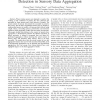Free Online Productivity Tools
i2Speak
i2Symbol
i2OCR
iTex2Img
iWeb2Print
iWeb2Shot
i2Type
iPdf2Split
iPdf2Merge
i2Bopomofo
i2Arabic
i2Style
i2Image
i2PDF
iLatex2Rtf
Sci2ools
INFOCOM
2011
IEEE
2011
IEEE
Reconciling privacy preservation and intrusion detection in sensory data aggregation
—When wireless sensors are deployed to monitor the working or life conditions of people, the data collected and processed by these sensors may reveal privacy of people. The actual content of sensory data should be concealed to preserve the privacy, but the data concealment feature may be abused by compromised sensors to modify or ill-process data without being caught. Hence, reconciling privacy preservation and intrusion detection, which apparently conflict with each other, is important. This paper studies this problem in the context of sensory data aggregation, a fundamental primitive for efficient operation of sensor networks. A scheme is proposed that can detect illperformed aggregation without knowing the actual content of sensory data, and therefore allow sensory data to be kept concealed. The results show that, the actual content of raw and aggregated sensory data can be well concealed. Meanwhile, most of ill-performed aggregations can be detected; the ill-performed aggregati...
| Added | 30 Aug 2011 |
| Updated | 30 Aug 2011 |
| Type | Journal |
| Year | 2011 |
| Where | INFOCOM |
| Authors | Chuang Wang, Guiling Wang, Wensheng Zhang 0001, Taiming Feng |
Comments (0)

